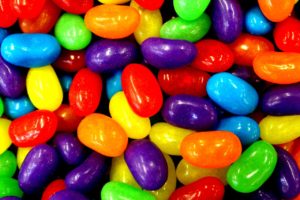Dessert ideas designed to help reduce added sugar intake while simultaneously providing a sweet treat.
After my post on sugar, many people asked if I have sweet treats in my household. Many wondered what my 5 year old daughter eats, or perhaps is allowed, for sweets. True, kids love sweets, and a child is born with a natural liking for sugar. Unlike the taste for salt, the taste for sweet does not need to be taught. As Michael Moss describes in his book, “Salt Sugar Fat” (2013) children are naturally attracted to sugar, and they have a higher “bliss point” for sugar than adults do. “Bliss point” is the exact amount of sweetness, no more, no less, that makes food and drink most enjoyable, and companies spend much money on research to determine the bliss point for their products. It is fair to say that I am very conscientious about what I serve to my family, as I view feeding my family well to be an important job. However, it is also true that I do not live in a bubble, I am not an ogre, and I have a soft heart. I enjoy a good dessert, a trip to the ice cream shop, and kettle corn at the farmer’s market. Baking with my daughter is a joy I will not give up. Here are a few strategies we use in our household to survive the dessert dilemma and keep our added daily sugar intake within (or as close to) the World Health Organizations recommendations of 24-36 grams of added sugar each day.
 Make choices. At a young age, I taught my daughter that in our family we “make pickers”. Not sure why I used that term at the time, but it stuck. Everyday we make “pickers”, not only in food choices or sweet treats, but in daily activities. I engage my daughter in making choices. Should we have broccoli or cauliflower? Do you want to ride bikes or walk? Would you like to have a muffin now or dessert later? My daughter has learned that life is about making “pickers”, and we stick with the choices me make. If you chose to have your daily added sugar at breakfast, do not eat more added sugar later in the day. The choice has been made.
Make choices. At a young age, I taught my daughter that in our family we “make pickers”. Not sure why I used that term at the time, but it stuck. Everyday we make “pickers”, not only in food choices or sweet treats, but in daily activities. I engage my daughter in making choices. Should we have broccoli or cauliflower? Do you want to ride bikes or walk? Would you like to have a muffin now or dessert later? My daughter has learned that life is about making “pickers”, and we stick with the choices me make. If you chose to have your daily added sugar at breakfast, do not eat more added sugar later in the day. The choice has been made.
Water and milk only. These are the only two beverage choices available to my daughter at home. The “adult list” expands to include tea, coffee, and an occasional glass of wine or beer. No soda. Watered down fruit juice becomes an option while on vacation only. We did however, make lemonade this summer from fresh lemons brought over by a neighbor. Lessons were taught and memories made as my daughter cut and squeezed the lemons while I controlled the sugar. She added mint from the garden and raspberries . We sipped our lemonade from glass jars while enjoying a sunny afternoon on the patio.
No candy. This is an easy rule for our family. My daughter does not like chocolate. I repeat…my daughter does not like chocolate. Can you believe it? I had trouble believing it at first, but because my dad does not care for chocolate either, I knew that there were a few “unique” taste buds out there. When she was two, she was served a slice of chocolate chip zucchini bread at a family gathering. She happily grabbed the slice and ran off with the other kids. A few seconds later, I felt a tap on my shoulder. I turned around to find a small hand filled with a half eaten gooey mess shoved in my face. “I don’t like it”. It wasn’t the zucchini. It was the chocolate. How can my daughter not like chocolate? Is she my daughter? Over the past few years, she has tried chocolate on occasion, thinking perhaps her taste buds are changing as she gets older. No luck. She even tried a leaf from a chocolate basil plant recently, only to spit it out. Some would view this as a blessing. I prefer to call it a mixed blessing. Perhaps it is just my selfish side wishing my daughter liked chocolate, so I could have the experience of sharing warm chocolate chip cookies with her over a glass of ice milk.

Other types of candy are off-limits too. Halloween is a wonderful time, and we happily walked door-to-door with Snow White last year to collect treats. My husband bought all of our daughter’s candy, and she was thrilled to make some “pickers” in the toy department of Target. The opportunity to have her own money to pick out toys was enough motivation for her to give up her candy. However, she also believes that she is allergic to the dyes in candy. O.k. I have to confess. When she was young, we were heading on a long plane trip. She had a cold, so I bought a bag of gummy bears in case her ears became uncomfortable. She had some of the candy and developed a rash below her bottom lip. I know the rash had nothing to do with the few gummy bears she ate, but instead was related to her cold. However, I could not pass up this opportunity to convince her she was allergic to the dyes in candy just like other kids were allergic to peanuts. Three and a half years later, she still believes this lie, does not eat candy, and I have not been struck by lightning. I believe that sometimes it is o.k. for parents to tell a small lie when keeping their child’s best interest at heart. Right?? Agree?? Please!

Yogurt, custard or fruit for dessert. Unless it is a birthday or other special occasion, dessert options in our household include fruit, plain yogurt with healthy toppings (fruit, nuts, seeds, unsweetened coconut) or baked custard. My Mom made baked custard for the family when I was a kid. I liked mine topped with sliced bananas. This same family custard recipe has become a favorite at our dinner table. It is very low in added sugar, and I serve it in individual dishes. We each make our own “pickers” of how we would like to “dress our desert”. I try and allow my daughter to play a role in the food preparation, as she is then much more accepting of the meal, or dessert, that is served. Last night we pretended we were at a restaurant, and the dessert choices were baked custard or plain yogurt. She cut up fruit and presented the dessert in stainless cups, topped with some parsley to make things fancy. She was so proud to be serving the family, and we all enjoyed the dessert… only one mishap. The glass yogurt container slipped out of her hands and onto the tile floor. My restaurant experience was interrupted, and I cleaned up a soupy mess of yogurt and a million glass shards. No worries though. One benefit to not having ice cream for dessert: Custard doesn’t melt. Accidents happen. That is how we learn. My daughter sucked up her pride and offered to make dinner the next night.
Attach an experience to your choices. When we do have a traditional dessert such as cookies, ice cream or a piece of pie, I pick wisely and try and couple the treat with an experience such as the making of lemonade. A sweet treat has much more meaning and enjoyment when there is a memory or experience tied with it. I enjoy baking, and a good pie is a work of art. We usually start with a trip to the farmer’s market. From rolling out the dough to forming the crust and finally watching the pie cool on the counter, the entire process is a wonderful way to spend time with my daughter, and I also know exactly what is in my pie. When in the mood for a delicious pastry, we go to our favorite bakery, Pavel’s Backerei in Pacific Grove. We sit outside and people watch or take the treat to the beach. We still laugh about how the seagulls have on two occasions stolen our treat right out of our hands. We typically do not have ice cream in the house. I once had a coworker who never had treats in her house. If she really wanted a dessert, she had to bike or walk to get it. I thought this was a wonderful opportunity to be outside, exercise and experience the community. Locally, we enjoy MYO Frozen Yogurt shop. Not only can we control the portions, they have a wide range of toppings to make “pickers.” A small serving with fruit becomes a nice pit stop during a bike ride.

I admit that my family did eat more sugar in years past than we currently do. It has been a gradual process of reducing added sugar in our diet and arriving at the diet we have today. We do not deprive ourselves of sugar. We are conscientious and over time have gotten used to a reduced amount of added sugar. Our “bliss point” has altered, and our perception of sweetness has changed. My daughter returned from an end of the school year celebration in early June, and when I asked her how the cupcakes were, she said, “The cake part was good, but the frosting was just too sweet.” Wow. Could you say that again? My heart skipped a happy beat knowing that my work has paid off and even a kid’s perception of sweetness can change.
The desert dilemma is no longer a dilemma in our household. Our sweet tooth is happy, and I have successfully worked sweetness into our diet in a controlled, healthy fashion. I write this while sipping a vanilla latte from a nearby coffee shop. Yes, it does have added sugar. I made a “picker” as to how I will spend my sugar allowance today. How sweet it is.


The first bite of a desert is the best